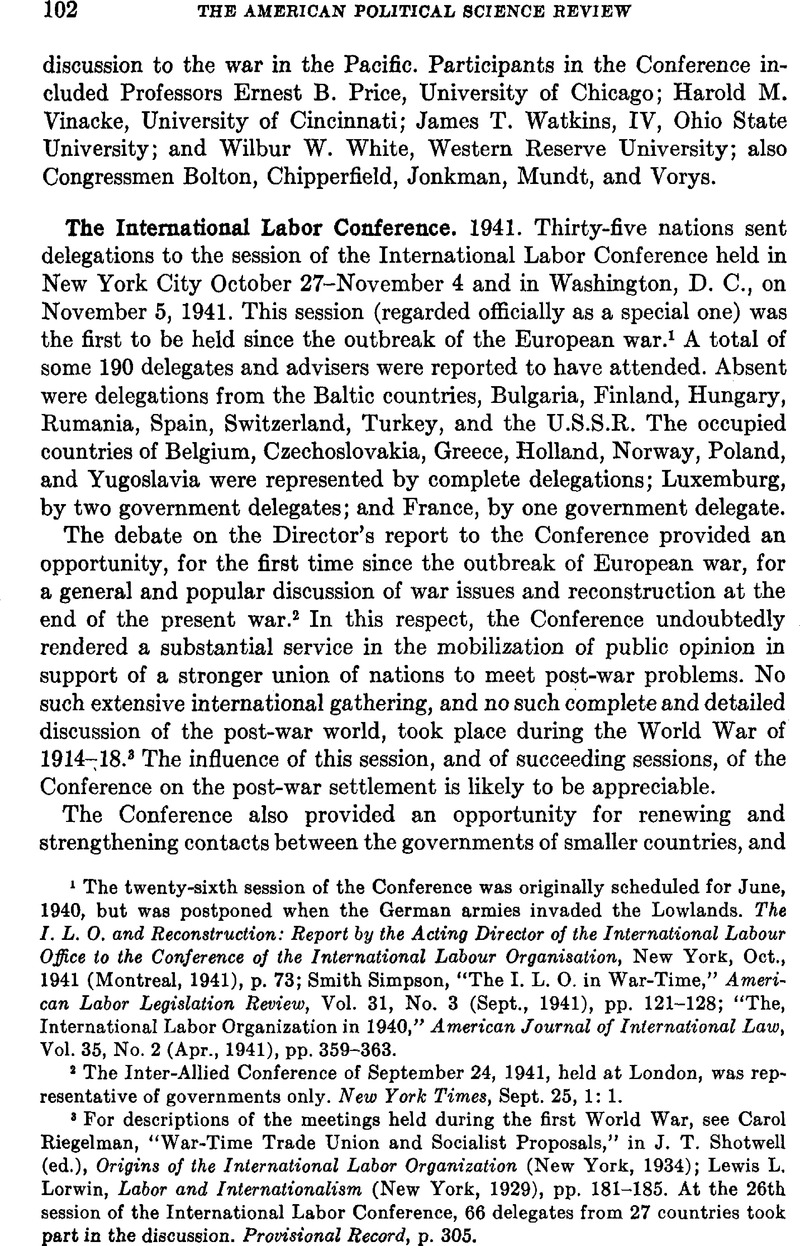Article contents
The International Labor Conference
Published online by Cambridge University Press: 02 September 2013
Abstract

- Type
- News and Notes
- Information
- Copyright
- Copyright © American Political Science Association 1942
References
1 The twenty-sixth session of the Conference was originally scheduled for June, 1940, but was postponed when the German armies invaded the Lowlands. The I. L. O. and Reconstruction: Report by the Acting Director of the International Labour Office to the Conference of the International Labour Organisation, New York, Oct., 1941 (Montreal, 1941), p. 73; Simpson, Smith, “The I. L. O. in War-Time,” American Labor Legislation Review, Vol. 31, No. 3 (Sept., 1941), pp. 121–128Google Scholar; “The, International Labor Organization in 1940,” American Journal of International Law, Vol. 35, No. 2 (Apr., 1941), pp. 359–363.
2 The Inter-Allied Conference of September 24, 1941, held at London, was representative of governments only. New York Times, Sept. 25, 1: 1.
3 For descriptions of the meetings held during the first World War, see Riegelman, Carol, “War-Time Trade Union and Socialist Proposals,” in Shotwell, J. T. (ed.), Origins of the International Labor Organization (New York, 1934)Google Scholar; Lorwin, Lewis L., Labor and Internationalism (New York, 1929), pp. 181–185.Google Scholar At the 26th session of the International Labor Conference, 66 delegates from 27 countries took part in the discussion. Provisional Record, p. 305.
4 New York Times, Nov. 3, 1941, 3: 3. See also the joint declaration made at the Conference by the governments and employers' and workers' delegates of Czechoslovakia, Greece, Poland, and Yugoslavia. Provisional Record, pp. 318–319.
5 Conference of the International Labor Organization, New York, Oct.-Nov., 1941. Resolutions adopted by the Conference (mim.)
6 Provisional Record, pp. 301–303. Objection was taken to the resolution by the Mexican Government on the ground that it involved a violation of national sovereignty. Ibid., p. 303. The special interest of the International Labor Organization in the textile industry dates from a resolution adopted by the eleventh session of the International Labor Conference in 1928 requesting an inquiry into working conditions in that industry. Record of Proceedings, International Labor Conference, Eleventh Session, 1928, pp. 354–357. This inquiry, although begun, was disorganized by the depression which began in 1929 and was not completed. The World Textile Conference, called by the I.L.O. in 1936, resumed the thread of interest. For the two monumental studies presented to the Textile Conference, see World Textile Industries, Studies and Reports, Series B, No. 27 (Geneva, 1937). For comments on the Conference, see Simpson, Smith, “The World Textile Conference,” Washington Post, Apr. 17, 1937Google Scholar, and “The I.L.O. Month by Month,” American Federalionist, Vol. 44, No. 5 (May, 1937) pp. 501–508. At the 86th session of the Governing Body (Feb., 1939), the International Labor Office was instructed to establish a tripartite textile committee “to consider labor conditions in the textile industries, taking into account those aspects of the industries which, directly or indirectly, may have a bearing on the improvement of those conditions, and to make recommendations to the Governing Body.” Minutes of the 86th Session of the Governing Body, pp. 54–61.
7 Provisional Record, pp. 339–342.
8 Idem, pp. 343–347.
9 Idem, pp. 349–361.
10 Idem, pp. 350–361.
11 Idem, pp. 322–328.
12 Idem, p. 328. No date was set for the next session of the Conference.
13 Idem, pp. 330–337.
- 1
- Cited by



Comments
No Comments have been published for this article.